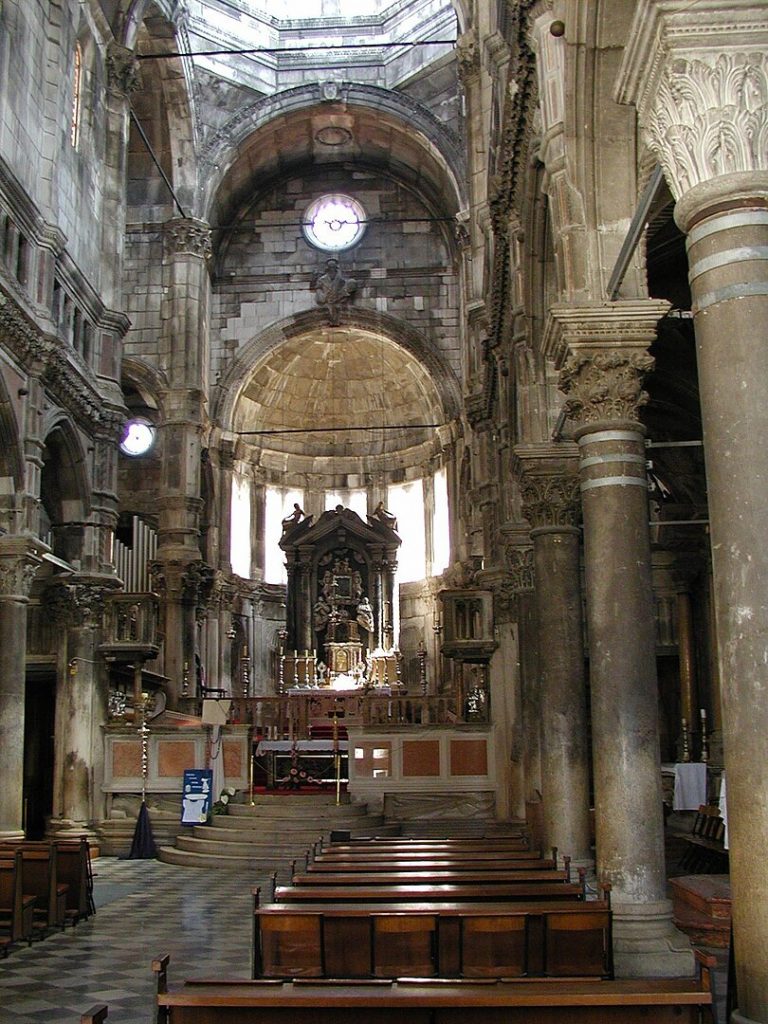
The Cathedral of Saint James in Šibenik, Croatia, stands as an extraordinary example of medieval architecture, with its distinctive blend of Gothic and Renaissance styles. This UNESCO World Heritage site is an architectural marvel that draws visitors and scholars alike. Located along Croatia’s picturesque Dalmatian coast, the Cathedral of Saint James is celebrated not only for its artistic grandeur but also for the innovative construction techniques used in its creation. In this article, we’ll delve into the architectural history, unique design elements, and the cultural significance of this remarkable cathedral.
Historical Background of the Cathedral of Saint James
The Cathedral of Saint James, or Katedrala Sv. Jakova, was built between 1431 and 1535. Construction of this grand edifice took over a century due to both technical challenges and shifts in architectural style. The initial design was laid out by Italian master architect Francesco di Giacomo, though later stages saw significant contributions from local architect Juraj Dalmatinac (also known as Giorgio da Sebenico) and his successor, Nikola Firentinac. The project’s extensive timeline allowed for a fusion of styles, creating a seamless blend of Gothic and Renaissance features that is rarely seen in European cathedrals.
Situated in the heart of Šibenik, the cathedral’s construction reflects the city’s medieval prosperity and its desire to assert its cultural and religious importance. The Cathedral of Saint James remains a testament to the ingenuity and dedication of the architects and builders who undertook this ambitious project.
Distinctive Architectural Styles
One of the most remarkable aspects of the Cathedral of Saint James is its harmonious mix of Gothic and Renaissance architectural styles. Early sections of the cathedral feature the pointed arches and ribbed vaults typical of Gothic architecture, which was widely popular in Europe during the 13th and 14th centuries. The transition to Renaissance styling is evident in the later construction stages, especially in the cathedral’s dome, vaults, and facade, which display the balanced proportions and classical elements characteristic of the Renaissance era.
This fusion is especially significant because it represents the influence of both Italian and Croatian architectural traditions. Dalmatinac’s role was instrumental in merging these two styles. The cathedral’s design features are not only architecturally intriguing but also reflect the cultural and historical crossroads that the Dalmatian coast represented during the late medieval period.
Unique Stone Construction Techniques
The Cathedral of Saint James is known for its stone construction, achieved through an innovative “interlocking” technique that sets it apart from other European cathedrals. Rather than using traditional mortar, the architects employed large stone blocks that interlocked perfectly, providing both structural integrity and aesthetic appeal. This construction method required precise craftsmanship and has contributed to the building’s remarkable durability over centuries.
This pioneering approach was crucial in creating the cathedral’s seamless appearance. Juraj Dalmatinac pioneered this style, drawing on his knowledge of local stone-cutting techniques and Mediterranean building traditions. The result is a structure that has withstood earthquakes, weather, and the passage of time, remaining in pristine condition and standing as a testament to the ingenuity of its builders.
The Dome: An Engineering Marvel
The dome of the Cathedral of Saint James is one of its most striking features. Designed by Nikola Firentinac, this dome is the first of its kind to be constructed entirely from stone, with no wood or supporting framework. Its impressive height of 38 meters (about 125 feet) makes it a dominant feature of Šibenik’s skyline.
This architectural feat was made possible by Firentinac’s expertise in both engineering and aesthetics. By employing precise calculations and expert craftsmanship, the builders achieved a harmonious balance between the dome’s weight and its structural supports. The design allowed natural light to filter into the cathedral’s interior, enhancing the sacred atmosphere. The dome remains a key example of Renaissance ingenuity, combining beauty with engineering prowess.
Iconic Facade and Sculptural Elements
The facade of the Cathedral of Saint James is an intricate masterpiece featuring sculptures and details that are both symbolic and decorative. One of the most celebrated aspects of the facade is the series of 74 sculpted heads that adorn the outer walls. Created by Dalmatinac, these heads represent various citizens of Šibenik, including children, men, and women, symbolizing the community’s close connection to the cathedral.
These faces add a distinctly human element to the architecture, reflecting the diversity of Šibenik’s population during the 15th century. It’s a rare example of personalized religious art and offers an intimate glimpse into the community that built and supported the cathedral. The inclusion of such figures underscores the architectural and cultural role the cathedral played as a communal space.
Interior Design and Decorative Details
Inside the cathedral, visitors are greeted with a sense of grandeur and spiritual serenity. The nave and aisles feature elegant stone arches and a vaulted ceiling, creating an impression of spaciousness and height. The interior’s restrained decoration directs attention to the purity of the architecture, with an emphasis on form and proportion rather than lavish ornamentation.
The altar, however, is richly adorned, drawing the eye toward the center of the sanctuary. Firentinac’s influence is evident in the refined details, including Corinthian columns and sculptural elements that exhibit Renaissance motifs. This balance between simplicity and elegance makes the interior of the Cathedral of Saint James a place of both spiritual reverence and aesthetic admiration.
UNESCO World Heritage Designation
In 2000, the Cathedral of Saint James was designated as a UNESCO World Heritage site, recognizing its outstanding architectural and historical significance. The UNESCO committee highlighted the cathedral as a unique example of stone construction and an innovative fusion of architectural styles. The cathedral’s designation as a World Heritage site has helped preserve its legacy, attracting attention from historians, architects, and travelers worldwide.
This recognition underscores the cathedral’s universal value, as it represents the convergence of Gothic and Renaissance architectural principles, executed with unparalleled craftsmanship. The UNESCO status ensures that this Croatian landmark will continue to be protected and appreciated for generations to come.
Preservation Efforts and Modern-Day Importance
Over the centuries, the Cathedral of Saint James has undergone several restoration efforts, particularly to counteract the effects of weathering and aging. One of the most notable restoration projects took place in the 19th century, ensuring that the cathedral maintained its structural integrity and aesthetic appeal. More recently, conservation efforts have focused on preserving the delicate sculptures and stonework that make the cathedral so unique.
Today, the cathedral is an active place of worship and a key cultural site for the people of Šibenik. It serves as a venue for religious ceremonies, concerts, and cultural events, solidifying its role as both a historical monument and a living part of the community. Visitors from around the world come to admire its architectural beauty, adding to its significance as a symbol of Croatian heritage.
The Cathedral’s Influence on Croatian Architecture
The Cathedral of Saint James has had a profound impact on architectural trends in Croatia and beyond. Its unique combination of Gothic and Renaissance styles has influenced numerous other structures along the Adriatic coast, where architects have drawn inspiration from its innovative design. The cathedral’s use of interlocking stone construction and its emphasis on humanistic elements have also shaped architectural practices in the region.
By blending Italian Renaissance ideals with Croatian craftsmanship, the cathedral became a model for integrating diverse architectural styles. Its legacy is evident in other churches and public buildings that reflect similar aesthetic principles, creating a cohesive architectural landscape that is distinct to this part of Europe.
Conclusion
The Cathedral of Saint James in Šibenik is a crowning jewel of Croatian architecture, reflecting both artistic mastery and cultural heritage. Its unique blend of Gothic and Renaissance styles, innovative stone construction, and symbolic sculptural elements make it a must-see for anyone interested in history, art, or architecture. As a UNESCO World Heritage site, the cathedral continues to captivate and inspire, preserving the rich history of Šibenik while serving as a symbol of resilience and creativity. Visiting this architectural wonder is not only a journey into Croatia’s past but also a chance to witness the remarkable craftsmanship that has stood the test of time.
Key Takeaways
- The Cathedral of Saint James is a UNESCO World Heritage site located in Šibenik, Croatia.
- It combines Gothic and Renaissance architectural styles in a unique blend.
- The cathedral is notable for its interlocking stone construction technique.
- Sculptures on the facade, especially the 74 carved heads, symbolize the Šibenik community.
- Restoration efforts have preserved the cathedral, which continues to serve as a cultural and religious center.
FAQs
- What styles influence the Cathedral of Saint James?
The cathedral combines Gothic and Renaissance architectural styles. - Who were the main architects of the Cathedral of Saint James?
Francesco di Giacomo, Juraj Dalmatinac, and Nikola Firentinac contributed to its design. - Why is the Cathedral of Saint James significant?
Its unique stone construction, artistic elements, and cultural symbolism make it a valuable historical landmark. - When was the Cathedral of Saint James designated a UNESCO World Heritage site?
It was designated as a UNESCO World Heritage site in 2000. - What is special about the cathedral’s dome?
It’s the first stone dome of its kind in Europe, constructed without wood support.




